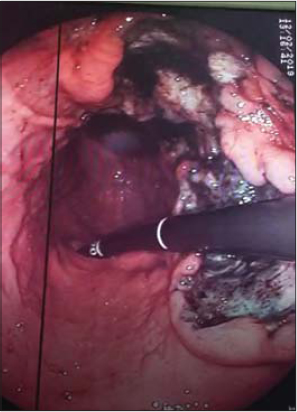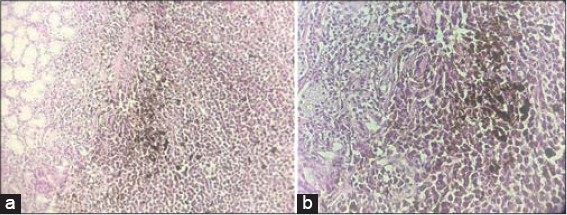Gastric metastasis of acrolentiginous melanoma
Selma El Kadiri 1, Sara Elloudi1, Rhizlane Chaoui1, Zakia Douhi1, Hanane Bay Bay1, Fatima-Zahra Mernissi1, Leila Chbani2, Imane Gouzi2
1, Sara Elloudi1, Rhizlane Chaoui1, Zakia Douhi1, Hanane Bay Bay1, Fatima-Zahra Mernissi1, Leila Chbani2, Imane Gouzi2
1Departement of Dermatology, CHU Hassan II, Fez, Morocco, 2Anatomopathology Department, CHU Hassan II, Fez, Morocco
Corresponding author: Dr. Selma El Kadiri, E-mail: elkadiri-s@hotmail.com
Submission: 16.01.2020; Acceptance: 13.02.2020
DOI: 10.7241/ourd.2020e.12
Cite this article: El Kadiri S, Elloudi S, Chaoui R, Douhi Z, Bay Bay H, Mernissi F-Z, Chbani L, Gouzi I. Gastric metastasis of acrolentiginous melanoma. Our Dermatol Online. 2020;11(e):e12.1.
Citation tools:
Copyright information
© Our Dermatology Online 2020. No commercial re-use. See rights and permissions. Published by Our Dermatology Online.
The stomach is a rare site of melanoma metastasis [1]. We report a base of a 63-year-old patient with a history of acrolentiginous plantar left melanoma with surgical, and lymphatic node excision 5-years ago who presented to the hospital complaining of intermittent epigastralgia and a transit-metastasis. A body scanner was performed and showed two hepatic nodules with antro-fundic thickening. An esophago-gastro-duodenoscopy showed a 6-centimeter pigmented crater involving the lesser curvature with raised and irregular borders (Fig. 1). Pathology revealed that the stomach was infiltrated by a population of atypical pigmented tumor cells (Figs. 2a and 2b). The cells expressed the melanoma marker HMB-45 and melan-A on immunohistochimical stains confirming the diagnostic of gastric metastasis of melanoma. Serum LDH level was elevated. The patient’s file was discussed in a multidisciplinary consultation meeting and palliative dacarbazine-type chemotherapy was adopted for this patient.
Consent
The examination of the patient was conducted according to the Declaration of Helsinki principles.
The authors certify that they have obtained all appropriate patient consent forms. In the form the patient(s) has/have given his/her/their consent for his/her/their images and other clinical information to be reported in the journal. The patients understand that their names and initials will not be published and due efforts will be made to conceal their identity, but anonymity cannot be guaranteed.
REFERENCE
1. Liang KV, Sanderson SO, Nowakowski GS, Arora AS. Metastatic malignant melanoma of the gastrointestinal tract. Mayo Clinic Proceedings. 2006;81:511–16.
Notes
Source of Support: Nil
Conflict of Interest: None
Request permissions
If you wish to reuse any or all of this article please use the e-mail (brzezoo77@yahoo.com) to contact with publisher.
| Related Articles | Search Authors in |
|
 http://orcid.org/000-0003-3455-3810 http://orcid.org/000-0003-3455-3810 |





Comments are closed.